If you’re looking for a quick and easy way to add peppery and smoky flavors to your dishes, try my homemade gochujang recipe! Gochujang is the perfect Korean ingredient when I want to add a little spice and smokiness to my food. My recipe is vegan and ready in less than 10 minutes. No fermentation needed!
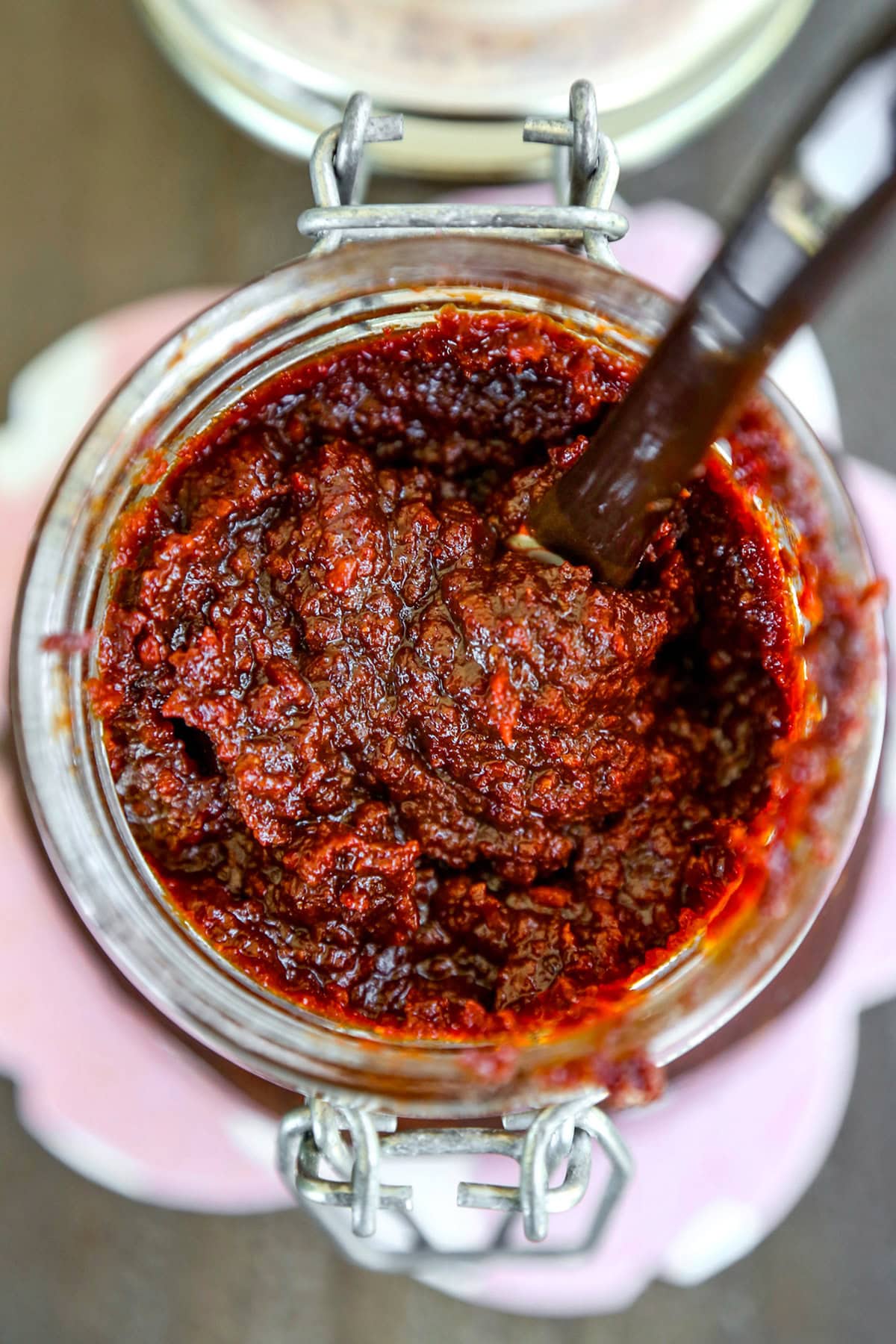
Why This Recipe Works
- Easy to make. Seven easy to find ingredients and only 10 minutes to make. It doesn’t get any easier than that!
- Tastes like the real thing. The flavors are so well balanced that you won’t be able to tell the difference between store bought gochujang and this homemade version.
- Versatile. Gochujang is such a versatile ingredients! It can be used to flavor soups and stews, add smoke and heat to a dipping sauce or a sandwich spread, or used in marinades for various proteins.
Table of contents

Gochujang 고추장 is a Korean red pepper paste made from fermented soybean, meju powder (fermented soybean powder), glutinous rice, gochugaru (Korean red pepper powder), and salt. It’s an ingredient I use all the time and not only with popular Korean dishes like tteokbokki, kimchi jjigae, and chicken bulgogi. I also love using it in Japanese dishes as well, such as my spicy natto recipe and pan fried tofu with gochujang sauce.
Gochujang is used as a flavor enhancer in soups, stews, and salads, and for pickling and marinating meats, seafood, tofu, and vegetables. The flavor profile is quite impressive: while doenjang (Korean fermented soybean paste) is salty and earthy – very similar to miso paste – gochujang has a strong spicy, smoky, umami, sweet, and nutty flavor that’s pungent and hard to compare to anything else.
Because of its thick and sticky texture – like a paste – gochujang has to be cooked in liquid or mixed with other ingredients to be consumed (it cannot be used as a finishing sauce or dipping sauce).
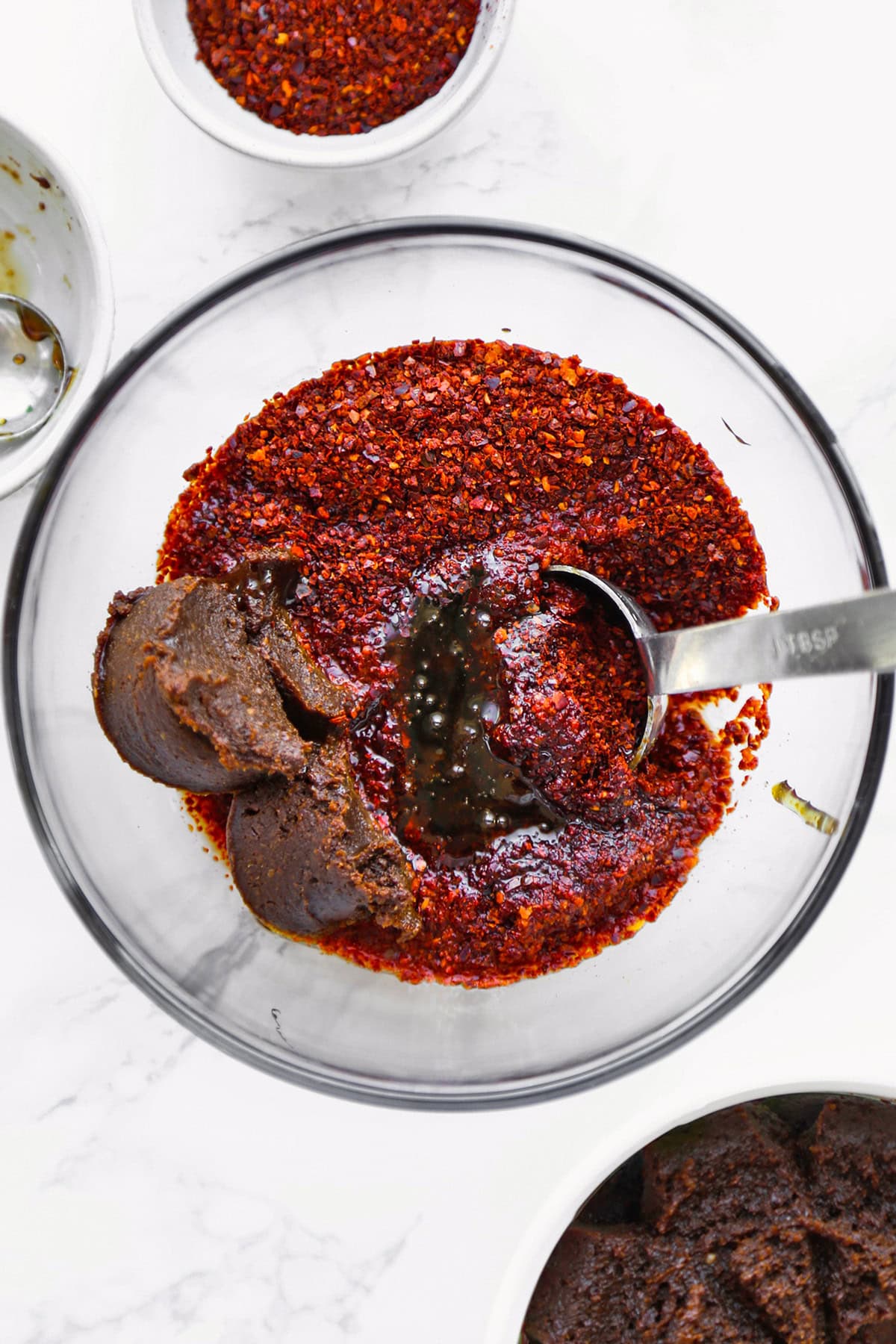
Ingredients
- Gochugaru (Korean red pepper flakes): This is what gives the sauce its spicy and super smoky flavor. Without gochugaru you cannot make gochujang as there is nothing else like it that would make a good substitute.
- Water: The water is to soften the Korean pepper flakes a create a paste.
- Honey: You can use any basic honey for this dish, it doesn’t have to be raw or anything like that. The honey adds a floral note and some sweetness.
- Red miso paste: Yes it has to be red miso paste for this recipe, sorry guys! The reason being that red miso is smoky and salty, unlike white miso which isn’t smoky at all and has a sweeter taste.
- Sake: You can use drinking sake or cooking sake, just a little is needed to add a little sweetness.
- Rice vinegar: Half a teaspoon is all we need to balance the sweetness and saltiness.
- Salt: The addition of red miso paste already adds saltiness but I’m adding a little extra so that it can stand up to the strong smoky taste.
Flavor Variations
- Make it more spicy: Add 1-2 additional tablespoons of gochugaru (you might need to add an extra tablespoon or two of water as well).
- Make it less spicy: Use 2 tablespoons gochugaru and 1/4 cup water instead of what the original recipe calls for.
- Make it more sweet: Add an extra tablespoon of honey.
- Make it more pungent: Add an extra teaspoon or two of rice vinegar.

How to Make It
- Have all your ingredients measured and ready to use.
- Put the gochugaru, water, miso paste and honey in a small pot and turn the heat the medium.
- Stir until the mixture starts to bubble and turn the heat off. Let the mixture cool about 15 minutes, until it reaches room temperature.
- Stir in the remaining ingredients and transfer the gochugaru paste in a jar or other glass or plastic airtight container. Enjoy!
Storage
Keep homemade gochujang in an airtight storage container. It should keep in the fridge for about 1 month.
For store bought gochujang, the shelf life is a lot longer.
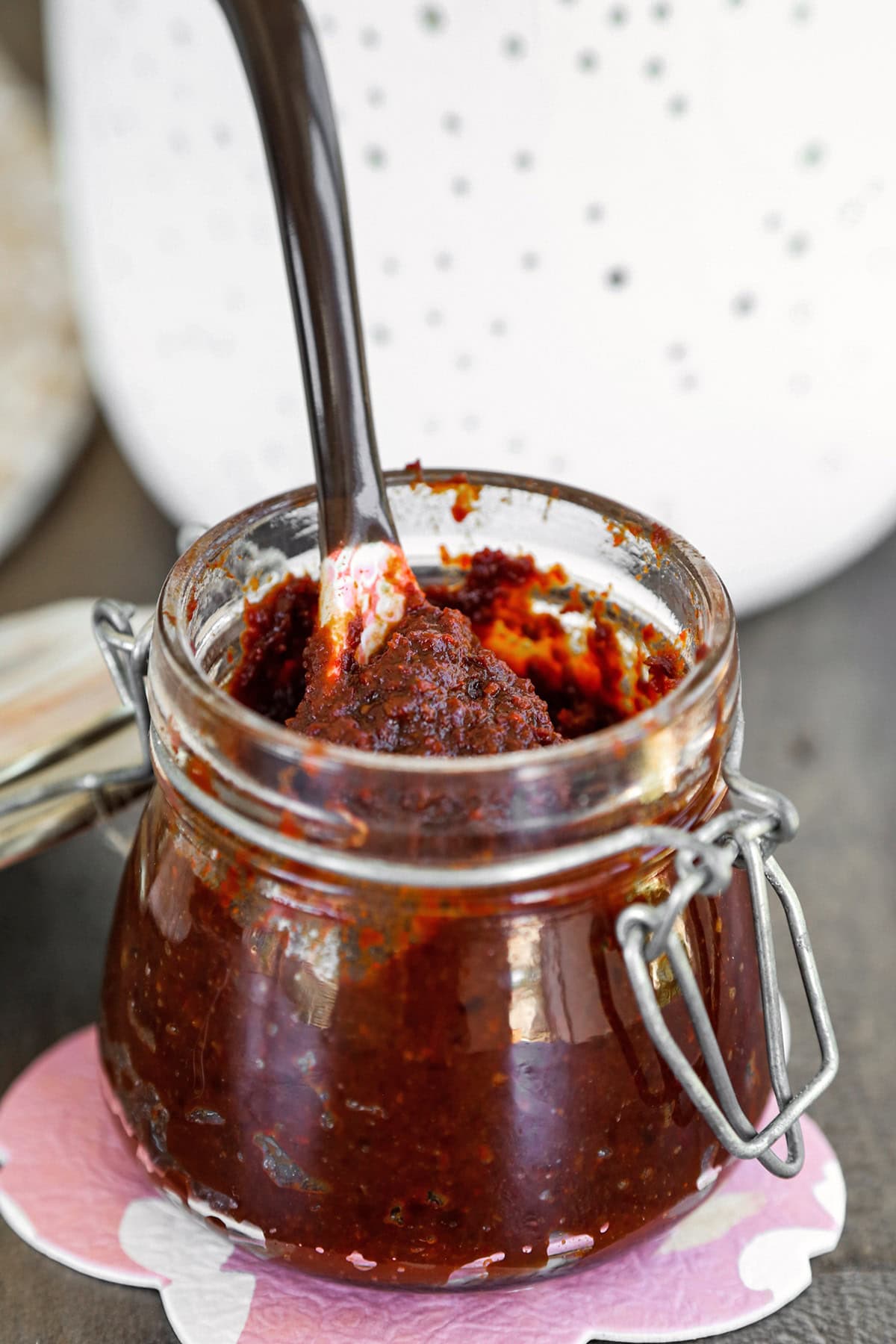
How to Use It
Use my gochujang recipe to enhance dishes with a little smokiness, heat, and funk.
FYI: a little goes a long way!
- If you are making a simple stir fry and would like more flavor, adding 1 teaspoon of gochujang will add depth of flavor and some heat.
- The same thing goes for soups and stews that are either tomato based or broth based.
- You can also use gochujang as a sandwich spread. Mix about a teaspoon gochujang with 2-3 tablespoons mayonnaise and voila! You’ve just made a spicy Korean style sandwich at home.
- Lastly, you can make a delicious bibimbap sauce for your rice bowl.
The options are endless! The more familiar you will become with the intricate flavors of gochujang and the easier it will be to combine it with other ingredients.
Some of my favorite Korean dishes using gochujang: Ssamjang (Korean dipping sauce), Soondubu jjigae (Korean spicy tofu soup), spicy asparagus chicken stir fry, chilled potato noodles with spicy sauce, and Vegan bulgogi.
Frequently Asked Questions
The biggest clue is in the color. If your homemade gochujang looks more brown than red, and smells and tastes a bit off, it means it’s time to throw it out.
Yes you can but the flavor will not be the same. The result will be somewhere between doenjang – which tastes just like white miso paste – and gochujang. Gochujang is very strong and needs the saltiness and aggressiveness of red miso paste to achieve the overall pungent, salty, smoky, and umami flavors.
Yes it is! This homemade gochujang recipe is 100% gluten-free.
Did you like this recipe? Are there changes you made that you would like to share? Share your tips and recommendations in the comments section below!
Print
Gochujang (Korean Chili Paste)
- Prep Time: 5 minutes
- Cook Time: 3 minutes
- Total Time: 8 minutes
- Yield: about 1 cup 1x
- Category: Sauces
- Method: Stove top
- Cuisine: Korean
- Diet: Vegan
Description
Learn how to make your own gochujang at home in less than 10 minutes. No fermentation needed!
Ingredients
- 1/4 cup gochugaru (Korean chili pepper flakes)
- 1/3 cup water
- 2 tablespoons honey
- 3 tablespoons red miso paste
- 1 1/2 tablespoon sake
- 1/2 teaspoon rice vinegar
- 1/4 teaspoon salt
Instructions
- Mix the first 4 ingredients in a pot: Add the gochugaru, water, honey, and miso paste to a pot and stir over medium heat until the mixture bubbles.
- Let the mixture cool down: Turn off the heat and leave for 15 minutes.
- Add the remaining ingredients: Stir in sake, vinegar and salt, and transfer the mixture to a bowl. Let cool to room temperature.
- Store it: Refrigerate for up to 1 month.
Notes
This homemade gochujang is best kept in an airtight container, somewhere dark and cool.
Nutrition
- Serving Size: 2 tablespoons
- Calories: 66
- Sugar: 4.3g
- Sodium: 73.4mg
- Fat: 0.4g
- Saturated Fat: 0g
- Unsaturated Fat: 0g
- Trans Fat: 0g
- Carbohydrates: 6.3g
- Fiber: 0.4g
- Protein: 0.8g
- Cholesterol: 0mg
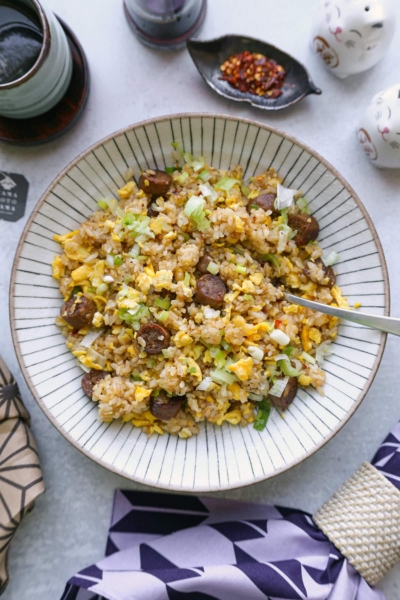
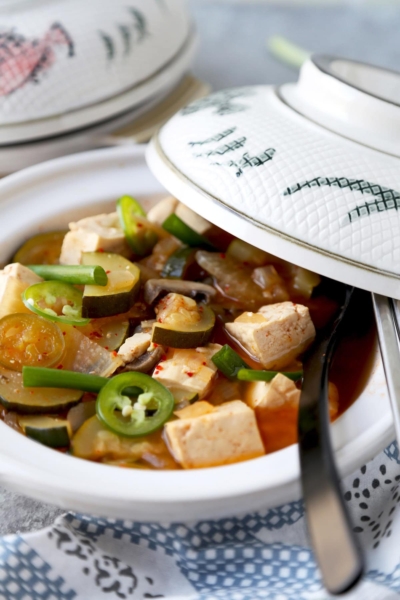
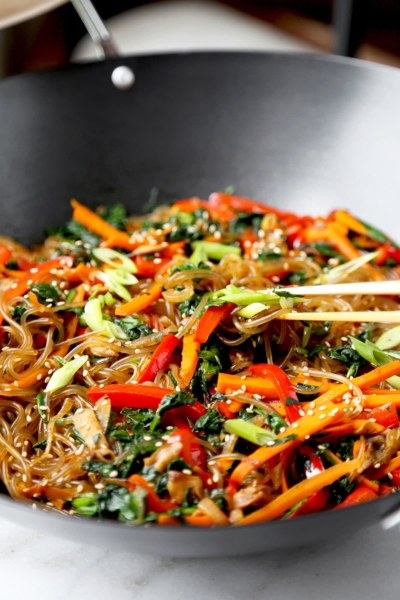
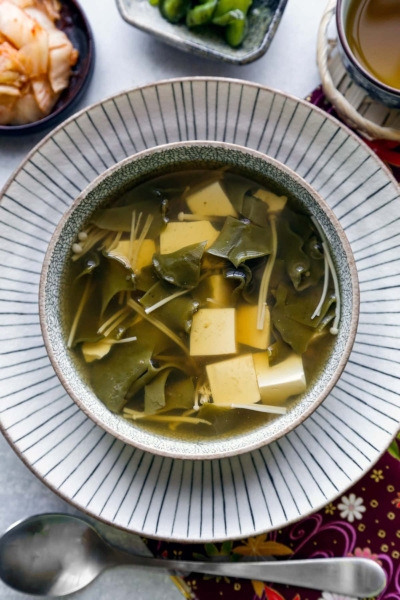















Questions and Reviews
Fantastic recipe! One note: While it may be vegetarian, honey makes this non-vegan (it is an animal product). Try corn syrup instead to maintain the consistency and sweetness!
Excellent directions clear-cut really easy to follow and great tips
I used this recipe to make my gochujang and then later used it to make sundubu jiggae. It turned out to be EXCELLENT. Thanks a lot
I ran out of gochujang to make dips using my garden’s winter storage crops and it’s more than an hour driving each way, so I decided to try Pickled Plum’s recipe. This recipe is great because it allows you to achieve your preferred levels of heat, sweet and salt. This is especially important because miso paste sold in America can vary widely in sweetness and saltiness. I cut the amount of honey in half, but it’s still nicely sweet, and I reduced the amount of sake slightly to obtain the final consistency I wanted. The consistency may differ because of the grind of the gochugaru.
Thanks, Caroline!
Thank you so much, Brian!
Mine was more of a sauce than a paste for whatever reason, but still delicious. Needed this for a noodle dish so it worked out fine.
I loved this recipe so much
Cool recipe! I’m glad I found a way to make gochujang from scratch. Condiments from scratch are the best and absolutely essential to healthy creative home cooking in my opinion. I used piloncillo (Mexican unrefined sugar) instead of the honey, grappa instead of sake and local grape vinegar instead of the rice vinegar. I also added a paste I made from rinsed and ground Chinese fermented black beans. It’s crazy delicious. Thanks for the inspiration!!!
Made this so i could make MaeunDakBulgogi (korean Spicy Chicken).Used saoxing chinese rice wine as i didn’t have sake to hand.It tastes nice and with the other ingredients for the bulgogi marinade is bathing my chicken in an overnight flavour bath.Am expecting a flavour bomb so will be served with just plain rice and quick pickled cucumber,english type as that’s what is alaways available here in GB.
So easy when you realise your tub of gochujang has run out so thanks so much it’s in my keep file now.
Thank you Lee! 🙂
Made this a few months back and compliments to the chef :), stunningly similar to the store-bought variety, with easy pantry ingredients.
Do you think it would work to use this recipe and still ferment it for six months like real gochujang?
Hi Naomi! I don’t know enough about fermenting to answer this question unfortunately. But the quick version is really delicious, I personally find it better than store bought gochujang!
You wrote that it can’t be used as a dip and can only be used in cooking: all Koreans use this as a dip and a spread (think ssam). It’s one of the banchan set at the table when eating a meal. My parents rarely cooked with it.
Thank you for sharing this tidbit of information Gee, I had never seen gochujang being used that way before. Good to know 🙂
Can it be frozen to extend the ‘shelf’ life? Thanks for this recipe – AND for posting nutrition numbers, i.e. fat, calories, etc. Terrific. CH
Made this a few months back and compliments to the chef :), stunningly similar to the store-bought variety, with easy pantry ingredients.
This is amazing! I’ve been looking for a gochujang without corn syrup, I’ll have to give this a try for sure. Do you have any suggestions for an alternative to the sake? I can’t tolerate any alcohol, sometimes I have added a little extra vinegar and sugar in other recipes, would that help here?
Hi! You can just take it out of the recipe and replace it with water (for the texture not to be too thick). Sake imparts a little sweetness so if you feel like your gochujang could use a little more sweetness, add a litte extra honey and that should do it 🙂
I ran out of gochujang from the store, so I used this recipe instead It tastes the same as the store brand, maybe better!
Thank you so much! 🙂
Wow this is an amazing & more easy to make recipe till now and it looks too delicious…i will trying to make it..Thanks for sharing…..!